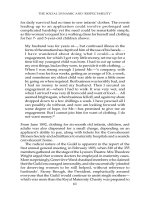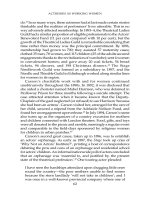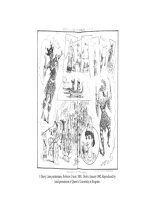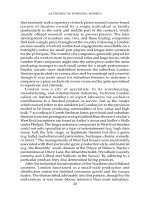ACTRESSES AS WORKING WOMEN 195
Bạn đang xem bản rút gọn của tài liệu. Xem và tải ngay bản đầy đủ của tài liệu tại đây (26.81 KB, 1 trang )
ACTRESSES AS WORKING WOMEN
24
25
26
27
28
29
30
31
32
33
34
35
36
37
See the Stage articles (1883–4) reprinted in Michael R.Booth (ed.) Victorian
Theatrical Trades, London, Society for Theatre Research, 1981. Only the variety
stage (loosely definable as music hall, a succession of unconnected ‘turns’
on a stage, and circus, primarily physical and visual rather than verbal with
unconnected acts performed in a ring) had interchangeable categories, with
music hall borrowing the physical acts such as Blondins, Leotards, and their
facsimiles.
Fit-ups and booth theatres are analogous, emerging out of statute and charter
fair traditions in the seventeenth century and continuing after the 1843 Act.
See Josephine Harrop, Victorian Portable Theatres, London, Society for Theatre
Research, 1989. For the sharing of duties, see Cecil Price, ‘Regulations of a
19th Century Theatrical Booth’, Theatre Notebook, 1949/50, vol. 4, pp. 8–9.
For background on the organization of English companies, see James
C.Burge, Lines of Business, Casting Practice and Policy in the American Theatre
1752–1899, New York, Peter Lang, 1986.
Gareth Stedman Jones, Outcast London: A Study of the Relationship Between
Classes in Victorian Society, Oxford, Clarendon Press, 1971, reprinted
Harmondsworth, Penguin, 1984, p. 27.
Genres of legitimate theatre, in contrast to the variety stage, are all
characterized by a unifying story line. The distinctive forms of drama,
comedy, farce, extravaganza, and pantomime are described by Michael R.
Booth in Prefaces to English Nineteenth-Century Theatre, Manchester,
Manchester University Press, 1980. Pantomime (exclusive of the
harlequinade), extravaganza (burletta), and ballet used many of the same
scenic features as well as a corp of female dancers, though ballet was a nonverbal form. Nineteenth-century burlesque was satirical, but unlike topical
farce (à la Toole) it used song and a corp of female dancers. The origins and
constant evolution of genres had a distinct bearing on employment traditions
and careers.
Stedman Jones, op. cit., p. 27.
E.T.Smith, ‘A Plea for the Theatre’, supplement to Era, 4 December 1860, p. 3.
Michael R.Booth, Victorian Spectacular Theatre 1850–1910, London, Routledge
& Kegan Paul, 1981, p. 85.
Greater London Record Office, Inspector’s Report, 5 December 1891, LCC/
MIN/10,769.
Documented cases include Helen Taylor, Mary Stafford (Flora Mayor), and
the anonymous author [Alma Ellerslie?] of The Diary of an Actress or Realities
of Stage Life, ed. H.C.Shuttleworth, London, Briffith, Farran, Okeden & Welsh,
1885.
T.W.Robertson, ‘Theatrical Types. No. IV.—Leading Ladies, Walking Ladies,
and Heavy Women’, Illustrated Times, 13 February 1864, p. 107.
At the Britannia Theatre (Hoxton), ‘super’ appears to have been a male
appellation, while ‘ballet girls’ served as walk-ons in dramatic pieces.
Leman Thomas Rede, The Road to the Stage, London, J.Onwhyn, 1836, p. 15.
T.W.Robertson, ‘Theatrical Types. No. VIII—Chambermaids, Soubrettes, and
Burlesque Actresses’, Illustrated Times, 23 April 1864, p. 267.
Davenport Adams, ‘Neglected Lines. III.—The Light Comedian and the
Singing Soubrette’, Stage, 2 April 1896, p. 8.
166









